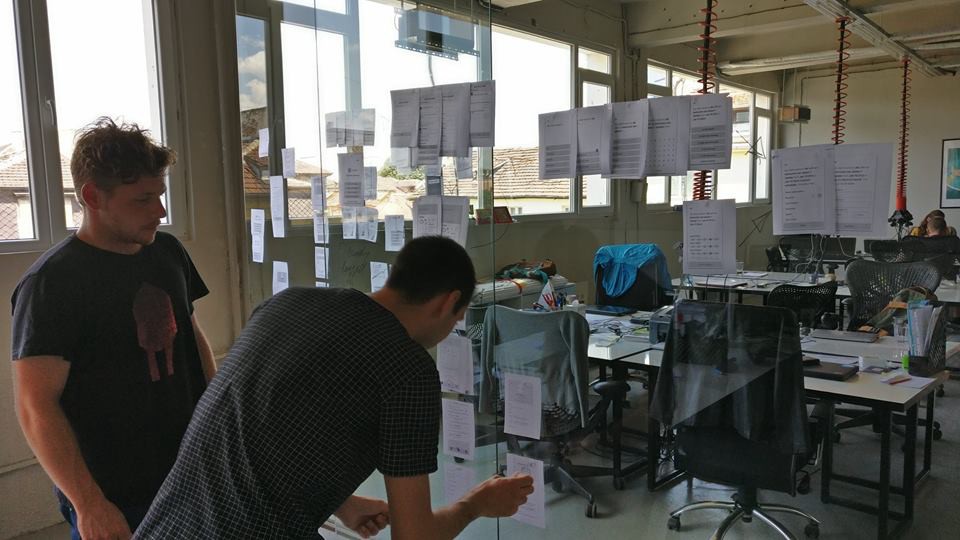Creating a Request for Proposal to find the right partner and relationship for your company’s project can be tedious. If you’ve already been there, you are well aware of the risks involved. If you haven’t, it is easy to get overwhelmed right from the start.
Competent RFPs are more likely to result in quality responses, written by agencies that best match your business and project goals. This in turn is more likely to lead to a good working relationship and a better solution for the business problems you’ve identified. Reassuring, perhaps, but you may not be convinced that you need one at all.

Christa Dodoo — Unsplash
Do you really need an RFP?
The Request for Proposal ensures a systematic and transparent approach to partner selection. Plus, the efforts of drafting the RFP involve a better understanding of the project internally and the stakeholders’ agreement on its goal and scope — a good starting ground for any business endeavour.
Even though the RFP is a widely used tool, its benefits clear, and the process well-travelled, it seems to provoke strong resentment. A TED talk by Cal Harrison (Beyond Referrals) compared RFPs to tonsil removal: “an outdated process that wastes millions of dollars.”
Forbes tuned in with “Why the RFP is a waste of time.” The No RFPs movement stated that “an industry that thrives on innovation surely can work on a better process — a process that focuses on building fruitful client-vendor relationships.”
Indeed, the RFP can be a cumbersome and resource-consuming process both for the issuer and the respondents. If it goes wrong, you could end up with no agency or with an agency that is not aligned with your vision and goals. And the worst part: you may have to repeat the process, facing the same risks. So, before you embark on an RFP, first decide if it is the right thing for you.

Jon Tyson — Unsplash
One of the ways to circumnavigate the RFP and still get an idea of what different agencies can bring to your project is to first send out a Request for Information (RFI). Typically, the RFI is a 1–2 page brief that states the broad business challenges you’re having. Its purpose is to get an overview of what your potential partners could bring to your project. The questions you ask them should be open-ended and high-level.
The RFI is much quicker, less formal and invites the potential partners to work out the best solution in a dialogue format. It is especially handy when you are uncertain of the exact scope of your project. The RFI leaves it to the agency to decide how to address your business challenge and in what direction to steer the solution.
Research the market for the right kind of agency — consider size, location, business profile and cultural fit. After you’ve sent an RFI to 10 potential partners, you can choose the 3 or 4 you think are the best match, and meet them directly to discuss the project in detail.
Having gone through the RFI process, if you still think you need to evaluate your potential partners via RFP, here is how to go about it for maximum efficiency.
What you need to do before sending out the RFP
The RFP is a tool to be used to solicit proposals only after the needs of the project have been defined. So, the first step is to define them. Make sure all stakeholders agree why the company is doing the project and what the end goal is.
Next, agree on a set of assessment criteria and their priority. Some responses will compete on low cost, others on best quality, still others on the breadth of functionality. Work out what you value and what benefits your business the most. You’re balancing the expertise of the agency’s team with the limitations of your budget but in the end you want the best partner and product that you can afford.
Prepare for the RFP review process by streamlining all communication with the bidding agencies. Identify and assign a point of contact and a Q&A date. Set realistic internal deadlines for reviewing the responses. Underestimating the amount of time it will take you to answer additional questions on the RFP and to review the answers may affect your project’s launch, milestones and cost.
So how do you actually write an RFP? Here’s a template that works:

Company Profile and Project Brief
Describe your company.
Include a short description of who you are, what your purpose is, and what you do. Quote your revenue (clue for size and scale) and list key current projects. Introduce key members of the project team. This part of the RFP is your way of introducing yourself to a potential partner. It also has to convey how the project will fit into the company’s strategy and mission.
Provide information on the project.
Create a high-level brief, describing where you are now vs. where you envision yourself in the market once the solution is delivered. Show how the project is aligned with your business objectives. You can include a list of business problems, followed by a description of where you want to be once you’ve resolved each. Explain why you think now is the right time to start. Stay away from any details and requirements at this point.
List anything unusual upfront — security & confidentiality issues, or specific disclaimers.
Define the format of the responses.
Provide a consistent template for the responses to level the playing field and maintain control of the evaluation process.
Manage the project timetable.
Start the RFP early enough and give yourself buffer time. Keep in mind that many of the really good agencies won’t have the capacity to start work on your project straight away. Set a date for your evaluation team to be ready with their assessment. Define the timeframe for scheduling interviews, and for announcing the final decision. List expected dates (or ranges) for key project stages.
Partner Information
This section of the Request for Proposal is a chance for you to get to know your potential partners. Try to extract a sense of who the agency is and if they are the right match for you — not just how they’ll deliver, but the cultural fit as well. Ask yourself whether you are looking for someone to deliver a project solution only, or a partner beyond the project’s lifespan.
This goal is not to collect extensive information, but to have enough to assess whether the agency has the understanding, skill set and expertise you need. Focus on assessing intangibles — such as talent, strategic thinking, creativity and innovation potential — alongside tangibles. Processes, service levels and hourly rate are all important, but often obscure more relevant evaluation criteria. You will need information on similar projects, credentials and recognition, in order to assess the team’s expertise. Look into:
- Agency profile
- Strategy
- Structure
- Current and past clients
- Relevant experience of working on similar projects — to assess technical capability
- Relevant experience of working with similar small, medium, and enterprise clients
- Turnovers and revenues — to assess the size and stability
- Client references — contact them to assess the agency’s credibility
Project Overview
Now that each of the two parties have an understanding of the other, the RFP should focus on what they are going to do together — your project!
State the non-technical, business-process definitions of the problem and solution. Include:
- A brief on what the current system looks like and what is causing problems.
- A brief on what you want to build and why. Describe what specific users’ problems it solves or what market gap it fills.
- A description of how you expect your customers to use the new solution.
- Information on who your current customers are, how they interact with your product and what their user experience is.
- A definition of success criteria and deliverables (such as 1000 users by month 3) for the solution.
Make sure your brief is not too prescriptive — an overview of the project rather than specific requirements. This is about strategy, not tactics. Leave room for your potential partners to challenge your brief. Otherwise, you may get exactly what you wanted, only to find out it’s not what you need.
Project Requirements
This is the section of the Request for Proposal you should probably spend the most time on. You should define how the solution you want will integrate with or replace the existing systems and processes. Define the limitations you have. Keep in mind how you envision the solution to be used, and describe any specific needs.
Differentiate between what you need and what you want. If you really require a certain functionality, describe it in context of the problem it should be solving. If you think you want a functionality, identify this with words like “may,” “can,” and “optional.”
When defining the scope in the RFP, brands often quote requirements that describe the existing system. This is a natural starting point, but make sure you are not limiting yourself with these requirements. There may be a solution outside your current processes that would suit better your business objectives.
This is what you need to include:
- List your requirements line by line. Split the information into technical, functional, non-functional and support specifications.
- Describe each requirement in a measurable and comparable way.
- Provide an indication of the priority of requirements. You could use the MoSCoW method to distinguish between Must have, Should have, Could have, and Won’t have (at this stage) requirements.
- Define success criteria.
- Leave room for answers you didn’t anticipate — additional functions that the agency feels are suitable for your product.
Project Budget
Whilst budget may be a sensitive matter, can you afford to leave out one of the most crucial factors in the project design process? There are a lot of ways to achieve your goals, some more expensive than others. Without a framework, responding agencies might work to propose a perfect solution, and come in far beyond your budget.
Setting a realistic budget expectation upfront allows agencies to provide pragmatic responses that address the most important items of the scope first. They can focus on the key functionality, then evaluate other possible features against the remaining budget.
Additional Information
Building your project is the baseline requirement when selecting an agency, and the most important one. But what about added value? Do you want an agency that will build your app, or one that will help build your company?
This section of the RFP is an opportunity for you to explore what your potential partners can bring to the table. Ask questions such as:
- How do you envision the continuous optimisation process?
- How are you going to set up measurement and analytics, and use the data for ongoing improvements?
- How will you train us in using the system?
- Can you help us build the team to manage it?
- Do you have suggestions on how to advance the project further?

Charles Deluvio — Unsplash
So you’ve sent out the RFP. What’s next?
Assessing the responses you’ve received can be as challenging as creating the RFP. Give the process the attention it deserves, even if the clock is ticking.
Read the solution strategy the agency is proposing. Go back to the criteria you agreed on initially. Call the references. Try answering the questions “do we want to work with them?” and “what are they bringing to the table?”
Meet with 2 or 3 shortlisted candidates. Invite them to present their specific capabilities related to your needs. Introduce your team, get to know theirs. Keep the meetings structured with clear objectives. Discuss timelines, expected outcomes and how you will work together.
Takeaways
Stick to these key points to manage your RFP process efficiently. First, agree on what your goal is for this project. Research potential partners — approaching too many agencies will only make your job harder. Early vetting allows you to focus on the few that best match your goals.
Create a smart, lean and focused Request for Proposal. Ask only the questions you care about being answered. Issuing a feature-heavy RFP may seem like a safeguard, but you risk ending up with too much information to process, or with responses that are impossible to compare. Overloading your RFP can also affect the agencies — they might opt out if the internal resource cost of responding to your request is unreasonable.
Most importantly, try not to prescribe the solution — leave room for creative input. The end goal is to create the best possible solution to a problem. The project owner loses their advantage when the RFP limits the agency’s ability to demonstrate innovation and cost- or time-saving techniques. Narrow RFPs lead to both you and your partner doing a box-checking exercise. Set up the process so that it can get you value added, non-obvious results.
Even if your RFP had 101 questions about the agency’s history and past accomplishments, the answers may not have given you a clear idea of who they strive to be. You’re not hiring an agency’s past, you’re hiring its future — the leadership’s vision, the team culture & expertise, and their willingness to embrace challenges.
. . .
If you’ve got to the end of this and are feeling overwhelmed, you’re not alone. Although we’re seasoned responders to RFPs, we rarely expect you to issue one if you’re exploring whether to work with us. Coming up soon is our guide to getting ahead with defining your digital project vision and goals — our Discovery Toolkit — so if you’d like to be the first to know when that’s ready, join our Despark Insider mailing list by scrolling down to the footer.